NCERT Solutions for Exercise 12.2 Class 12 Maths Chapter 12 - Linear Programming
CBSE Class 12th Exam Date:01 Jan' 26 - 14 Feb' 26
NCERT Solutions For Class 12 Maths Chapter 12 Exercise 12.2
NCERT Solutions for Exercise 12.2 Class 12 Maths Chapter 12 Linear Programming are discussed here. These NCERT solutions are created by subject matter expert at Careers360 considering the latest syllabus and pattern of CBSE 2023-24. NCERT solutions for exercise 12.2 Class 12 Maths chapter 12 discuss a few types of linear programming problems. There are 11 practice questions given in exercise 12.2 Class 12 Maths. All these problems of NCERT solutions for Class 12 Maths chapter 12 exercise 12.2 are done using graphical methods. Manufacturing problems, diet problems, transportation problems are some of the linear programming problems given in the Class 12 Maths chapter 12 exercise 12.2. According to the given statements, the given objective functions and the constraints are formulated and then solved using graphical methods. Along with the Class 12 Maths chapter 12 exercise 12.2 solutions there are two more exercises.
All these NCERT problems are solved by Mathematics expert faculties and NCERT solutions for Class 12 Maths chapter 12 exercise 12.2 can be used for the preparation of the CBSE Class 12 Board Exam. 12th class Maths exercise 12.2 answers are designed as per the students demand covering comprehensive, step by step solutions of every problem. Practice these questions and answers to command the concepts, boost confidence and in depth understanding of concepts. Students can find all exercise enumerated in NCERT Book together using the link provided below.
Access NCERT Solutions for Class 12 Maths Chapter 12 Exercise 12.2
Linear Programming Class 12 Chapter 12-Exercise: 12.2
Answer:
Let mixture contain x kg of food P and y kg of food Q. Thus, $x\geq 0,y\geq 0$ .
The given information can be represented in the table as :
Vitamin A | Vitamin B | Cost | |
Food P | 3 | 5 | 60 |
Food Q | 4 | 2 | 80 |
requirement | 8 | 11 |
The mixture must contain 8 units of Vitamin A and 11 units of Vitamin B.
Therefore, we have
$3x+4y\geq 8$
$5x+2y\geq 11$
Total cost is Z. $Z=60x+80y$
Subject to constraint,
$3x+4y\geq 8$
$5x+2y\geq 11$
$x\geq 0,y\geq 0$
The feasible region determined by constraints is as follows:
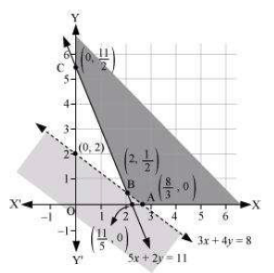
It can be seen that a feasible region is unbounded.
The corner points of the feasible region are $A(\frac{8}{3},0),B(2,\frac{1}{2}),C(0,\frac{11}{2})$
The value of Z at corner points is as shown :
corner points | $Z=60x+80y$ | |
$A(\frac{8}{3},0)$ | 160 | MINIMUM |
$B(2,\frac{1}{2})$ | 160 | minimum |
$C(0,\frac{11}{2})$ | 440 |
Feasible region is unbounded, therefore 160 may or may not be the minimum value of Z.
For this, we draw $60x+80y< 160\, \, or \, \, \, 3x+4y< 8$ and check whether resulting half plane has a point in common with the feasible region or not.
We can see a feasible region has no common point with. $\, \, 3x+4y< 8$
Hence, Z has a minimum value 160 at line segment joining points $A(\frac{8}{3},0)$ and $B(2,\frac{1}{2})$ .
Answer:
Let there be x cakes of first kind and y cakes of the second kind.Thus, $x\geq 0,y\geq 0$ .
The given information can be represented in the table as :
Flour(g) | fat(g) | |
Cake of kind x | 200 | 25 |
Cake of kind y | 100 | 50 |
Availability | 5000 | 1000 |
Therefore,
$200x+100y\leq 5000$
$\Rightarrow \, \, \, \, 2x+y\leq 50$
. $\, \, 25x+50y\leq 10000$
$\Rightarrow \, \, x+2y\leq 400$
The total number of cakes, Z. Z=X+Y
Subject to constraint,
$\Rightarrow \, \, \, \, 2x+y\leq 50$
$\Rightarrow \, \, x+2y\leq 400$
$x\geq 0,y\geq 0$
The feasible region determined by constraints is as follows:
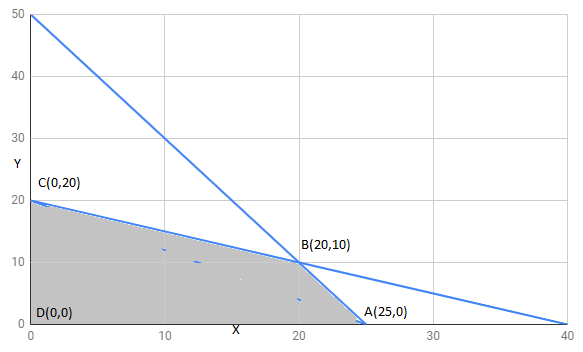
The corner points of the feasible region are $A(25,0),B(20,10),C(0,20),D(0,0)$
The value of Z at corner points is as shown :
corner points | Z=X+Y | |
$A(25,0)$ | 25 | |
$B(20,10)$ | 30 | maximum |
$C(0,20)$ $D(0,0)$ | 20 0 | minimum |
The maximum cake can be made 30 (20 of the first kind and 10 of the second kind).
(i) What number of rackets and bats must be made if the factory is to work at full capacity?
Answer:
Let number of rackets be x and number of bats be y.
the machine time availability is not more than 42 hours.
i.e. $1.5x+3y\leq 42$
craftsman’s time availability is 24 hours
i.e. $3x+y\leq 24$
The factory has to work at full capacity.
Hence, $1.5x+3y= 42...............1$
$3x+y= 24...............2$
Solving equation 1 and 2, we have
$x=4\, \, and\, \, \, y=12$
Thus, 4 rackets and 12 bats are to be made .
(ii) If the profit on a racket and on a bat is Rs 20 and Rs 10 respectively, find the maximum profit of the factory when it works at full capacity.
Answer:
Let the number of rackets is x and the number of bats is y.
the machine time availability is not more than 42 hours.
craftsman’s time availability is 24 hours
The given information can be repreented in table as shown :
racket | bat | availability | |
machine time | 1.5 | 3 | 42 |
craftman's time | 3 | 1 | 24 |
$1.5x+3y\leq 42$
$3x+y\leq 24$
$x,y\geq 0$
The profit on the bat is 10 and on the racket is 20.
$Z=20x+10y$
The mathematical formulation is :
maximise $Z=20x+10y$
subject to constraints,
$1.5x+3y\leq 42$
$3x+y\leq 24$
$x,y\geq 0$
The feasible region determined by constraints is as follows:
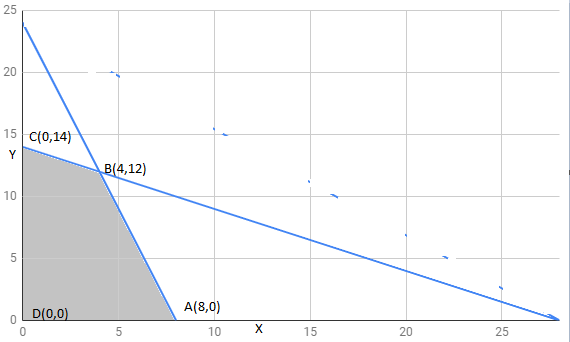
The corner points are $A(8,0),B(4,12),C(0,14),D(0,0)$
The value of Z at corner points is as shown :
CORNER POINTS | $Z=20x+10y$ | |
$A(8,0)$ | 160 | |
$B(4,12)$ | 200 | maximum |
$C(0,14)$ | 140 | |
$D(0,0)$ | 0 |
Thus, the maximum profit of the factory when it works at full capacity is 200.
Answer:
Let packages of nuts be x and packages of bolts be y .Thus, $x\geq 0,y\geq 0$ .
The given information can be represented in table as :
bolts | nuts | availability | |
machine A | 1 | 3 | 12 |
machine B | 3 | 1 | 12 |
Profit on a package of nuts is Rs. 17.5 and on package of bolt is 7.
Therefore, constraint are
$x+3y\leq 12$
$3x+y\leq 12$
$x\geq 0,y\geq 0$
$Z= 17.5x+7y$
The feasible region determined by constraints is as follows:
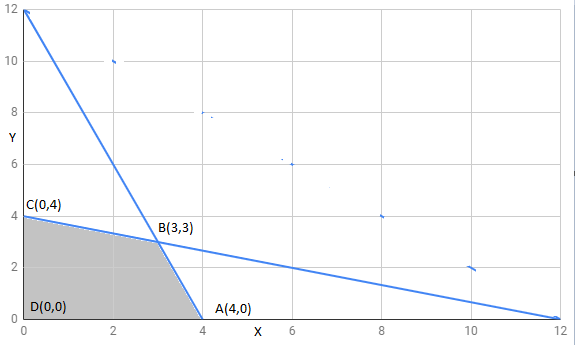
The corner points of feasible region are $A(4,0),B(3,3),C(0,4),D(0,0)$
The value of Z at corner points is as shown :
Corner points | $Z= 17.5x+7y$ | |
$A(4,0)$ | 70 | |
$B(3,3)$ | 73.5 | maximum |
$C(0,4)$ | 28 | |
$D(0,0)$ | 0 |
The maximum value of z is 73.5 at $B(3,3)$ .
Thus, 3 packages of nuts and 3 packages of bolts should be manufactured everyday to get maximum profit.
Answer:
Let factory manufactures screws of type A and factory manufactures screws of type B. Thus, $x\geq 0,y\geq 0$ .
The given information can be represented in the table as :
screw A | screw B | availability | |
Automatic machine | 4 | 6 | $4\times 60=240$ |
hand operated machine | 6 | 3 | $4\times 60=240$ |
Profit on a package of screw A is Rs.7 and on the package of screw B is 10.
Therefore, the constraint is
$4x+6y\leq 240$
$6x+3y\leq 240$
$x\geq 0,y\geq 0$
$Z= 7x+10y$
The feasible region determined by constraints is as follows:
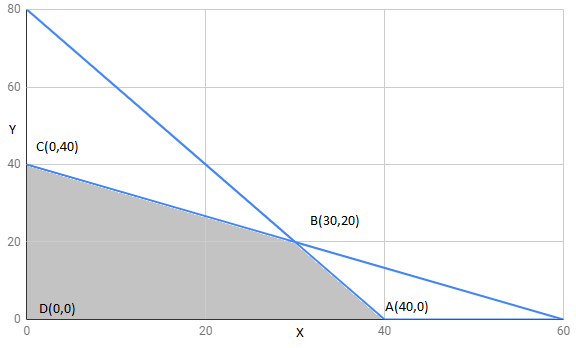
The corner points of the feasible region are $A(40,0),B(30,20),C(0,40),D(0,0)$
The value of Z at corner points is as shown :
Corner points | $Z= 7x+10y$ | |
$A(40,0)$ | 280 | |
$B(30,20)$ | 410 | maximum |
$C(0,40)$ | 400 | |
$D(0,0)$ | 0 |
The maximum value of z is 410 at $B(30,20)$ .
Thus, 30 packages of screw A and 20 packages of screw B should be manufactured every day to get maximum profit.
Answer:
Let the cottage industry manufactures x pedestal lamps and y wooden shades. Thus, $x\geq 0,y\geq 0$ .
The given information can be represented in the table as :
lamps | shades | availability | |
machine (h) | 2 | 1 | 12 |
sprayer (h) | 3 | 2 | 20 |
Profit on a lamp is Rs. 5 and on the shade is 3.
Therefore, constraint is
$2x+y\leq 12$
$3x+2y\leq 20$
$x\geq 0,y\geq 0$
$Z= 5x+3y$
The feasible region determined by constraints is as follows:
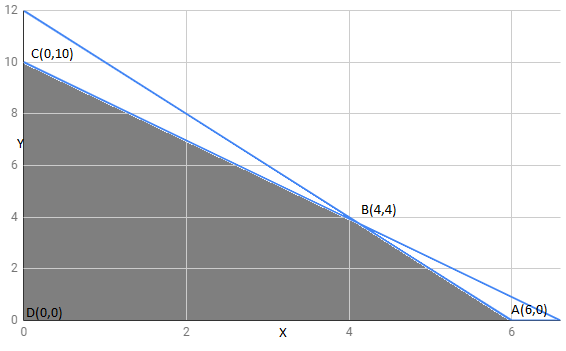
The corner points of the feasible region are $A(6,0),B(4,4),C(0,10),D(0,0)$
The value of Z at corner points is as shown :
Corner points | $Z= 5x+3y$ | |
$A(6,0)$ | 30 | |
$B(4,4)$ | 32 | maximum |
$C(0,10)$ | 30 | |
$D(0,0)$ | 0 |
The maximum value of z is 32 at $B(4,4)$ .
Thus, 4 shades and 4 pedestals lamps should be manufactured every day to get the maximum profit.
Answer:
Let x be Souvenirs of type A and y be Souvenirs of type B .Thus, $x\geq 0,y\geq 0$ .
The given information can be represented in table as :
Type A | Type B | availability | |
cutting | 5 | 8 | $(3\times 60)+20=200$ |
asembling | 10 | 8 | $4\times 60=240$ |
Profit on type A Souvenirs is Rs. 5 and on type B Souvenirs is 6.
Therefore, constraint are
$5x+8y\leq 200$
$10x+8y\leq 240$
$x\geq 0,y\geq 0$
$Z=5x+6y$
The feasible region determined by constraints is as follows:
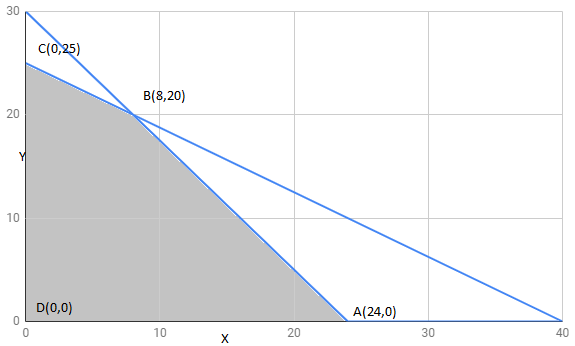
The corner points of feasible region are $A(24,0),B(8,20),C(0,25),D(0,0)$
The value of Z at corner points is as shown :
Corner points | $Z=5x+6y$ | |
$A(24,0)$ | 120 | |
$B(8,20)$ | 160 | maximum |
$C(0,25)$ | 150 | |
$D(0,0)$ | 0 |
The maximum value of z is 160 at $B(8,20)$ .
Thus,8 Souvenirs of type A and 20 Souvenirs of type B should be manufactured everyday to get maximum profit.
Answer:
Let merchant plans has personal computers x desktop model and y portable model
.Thus, $x\geq 0,y\geq 0$ .
The cost of desktop model is cost Rs 25000 and portable model is Rs 40000.
Merchant can invest Rs 70 lakhs maximum.
$25000x+40000y\leq 7000000$
$5x+8y\leq 1400$
the total monthly demand of computers will not exceed 250 units.
$x+y\leq 250$
profit on the desktop model is Rs 4500 and on portable model is Rs 5000.
Total profit = Z , $Z=4500x+5000y$
The mathematical formulation of given problem is :
$5x+8y\leq 1400$
$x+y\leq 250$
$x\geq 0,y\geq 0$
$Z=4500x+5000y$
The feasible region determined by constraints is as follows:
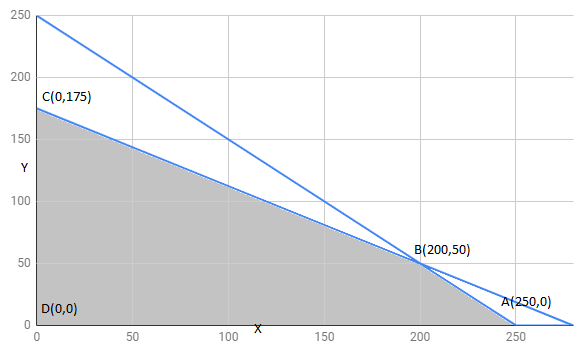
The corner points of feasible region are $A(250,0),B(200,50),C(0,175),D(0,0)$
The value of Z at corner points is as shown :
Corner points | $Z=4500x+5000y$ | |
$A(250,0)$ | 1125000 | |
$B(200,50)$ | 1150000 | maximum |
$C(0,175)$ | 875000 | |
$D(0,0)$ | 0 |
The maximum value of z is 1150000 at $B(200,50)$ .
Thus, merchant should stock 200 desktop models and 50 portable models to get maximum profit.
Answer:
Let diet contain x unit of food F1 and y unit of foof F2 .Thus, $x\geq 0,y\geq 0$ .
The given information can be represented in table as :
Vitamin | minerals | cost per unit | |
foof F1 | 3 | 4 | 4 |
food F2 | 6 | 3 | 6 |
80 | 100 |
Cost of food F1 is Rs 4 per unit and Cost of food F2 is Rs 6 per unit
Therefore, constraint are
$3x+4y\geq 4$
$6x+3y\geq 6$
$x\geq 0,y\geq 0$
$Z= 4x+6y$
The feasible region determined by constraints is as follows: 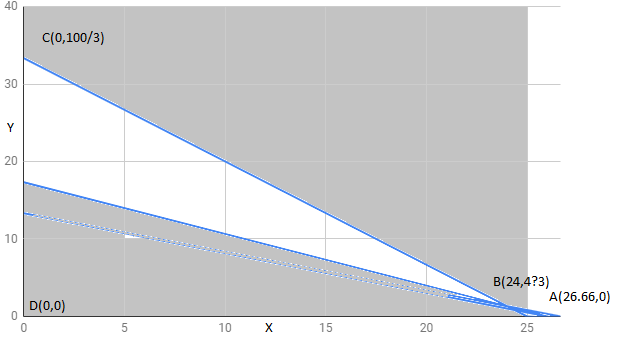
We can see feasible region is unbounded.
The corner points of feasible region are $A(\frac{80}{3},0),B(24,\frac{4}{3}),C(0,\frac{100}{3})$
The value of Z at corner points is as shown :
Corner points | $Z= 4x+6y$ | |
$A(\frac{80}{3},0)$ | 106.67 | |
$B(24,\frac{4}{3}),$ | 104 | minimum |
$C(0,\frac{100}{3})$ | 200 | maximum |
Feasible region is unbounded , therefore 104 may or may not be minimum value of Z .
For this we draw $4x+6y< 104$ or $2x+3y< 52$ and check whether resulting half plane has point in common with feasible region or not.
We can see feasible region has no common point with $2x+3y< 52$ .
Hence , Z has minimum value 104.
Answer:
Let farmer buy x kg of fertilizer F1 and y kg of F2 .Thus, $x\geq 0,y\geq 0$ .
The given information can be represented in table as :
Nitrogen | phosphoric acid | Cost | |
F1 | 10 | 6 | 6 |
F2 | 5 | 10 | 5 |
requirement | 14 | 14 |
F1 contain 10% nitrogen and F2 contain 5% nitrogen .Farmer requires atleast 14 kg of nitrogen
$10\%x+5\%y\geq 14$
$\frac{x}{10}+\frac{y}{20}\geq 14$
$2x+y\geq 280$
F1 contain 6% phophoric acid and F2 contain 10% phosphoric acid .Farmer requires atleast 14 kg of nitrogen
$6\%x+10\%y\geq 14$
$\frac{6x}{100}+\frac{y}{20}\geq 14$
$3x+56y\geq 700$
Total cost is Z . $Z=6x+5y$
Subject to constraint ,
$2x+y\geq 280$
$3x+56y\geq 700$
$x\geq 0,y\geq 0$
$Z=6x+5y$
The feasible region determined by constraints is as follows:
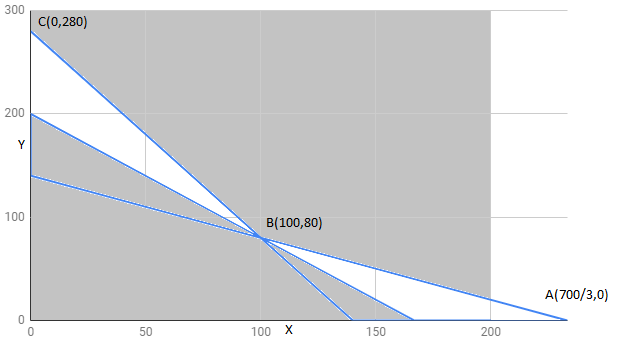
It can be seen that feasible region is unbounded.
The corner points of feasible region are $A(\frac{700}{3},0),B(100,80),C(0,280)$
The value of Z at corner points is as shown :
corner points | $Z=6x+5y$ | |
$A(\frac{700}{3},0)$ | 1400 | |
$,B(100,80)$ | 1000 | minimum |
$C(0,280)$ | 1400 |
Feasible region is unbounded , therefore 1000 may or may not be minimum value of Z .
For this we draw $6x+5y< 1000$ and check whether resulting half plane has point in common with feasible region or not.
We can see feasible region has no common point with $6x+5y< 1000$ .
Hence , Z has minimum value 1000 at point $,B(100,80)$
Question:11 The corner points of the feasible region determined by the following system of linear inequalities:
$2x+y \leq 10,x+3y \leq 15,x,y\geq 0$ are $(0,0),(5,0),(3,4)$ and $(0,5)$ . Let $Z=px+qy,$ where $p,q > 0.$ Condition on p and q so that the maximum of Z occurs at both $(3,4)$ and $(0,5)$ is
Answer:
The maximum value of Z is unique.
It is given that maximum value of Z occurs at two points $(3,4)\, \, and\, \, \, (0,5)$ .
$\therefore$ Value of Z at $(3,4)$ =value of Z at $(0,5)$
$\Rightarrow \, \, \, p(3)+q(4)=p(0)+q(5)$
$\Rightarrow \, \, \, 3p+4q=5q$
$\Rightarrow \, \, \, q=3p$
Hence, D is correct option.
More about NCERT Solutions for Class 12 Maths Chapter 12 Exercise 12.2
Before exercise 12.2 Class 12 Maths, there are 3 solved examples. The first examples are diet, allocation and manufacturing problems. The Class 12 Maths chapter 12 exercise 12.2 have 11 problems out of which 1 is a multiple-choice question. After exercise 12.2 there are miscellaneous examples and exercises for practice.
Also Read| Linear Programming Class 12th Notes
Benefits of NCERT Solutions for Class 12 Maths Chapter 12 Exercise 12.2
- For CBSE board exams students can expect one similar question as discussed in NCERT book exercise 12.2 Class 12 Maths
- The Class 12 Maths chapter 12 exercise 12.2 solutions are available for free and can be downloaded using any downloading tools
- These solutions will help students to improve their conceptual understanding
Key Features Of NCERT Solutions for Exercise 12.2 Class 12 Maths Chapter 12
- Comprehensive Coverage: The solutions encompass all the topics covered in ex 12.2 class 12, ensuring a thorough understanding of the concepts.
- Step-by-Step Solutions: In this class 12 maths ex 12.2, each problem is solved systematically, providing a stepwise approach to aid in better comprehension for students.
- Accuracy and Clarity: Solutions for class 12 ex 12.2 are presented accurately and concisely, using simple language to help students grasp the concepts easily.
- Conceptual Clarity: In this 12th class maths exercise 12.2 answers, emphasis is placed on conceptual clarity, providing explanations that assist students in understanding the underlying principles behind each problem.
- Inclusive Approach: Solutions for ex 12.2 class 12 cater to different learning styles and abilities, ensuring that students of various levels can grasp the concepts effectively.
- Relevance to Curriculum: The solutions for class 12 maths ex 12.2 align closely with the NCERT curriculum, ensuring that students are prepared in line with the prescribed syllabus.
Also see-
NCERT Solutions Subject Wise
Subject Wise NCERT Exemplar Solutions
- NCERT Exemplar Class 12 Maths
- NCERT Exemplar Class 12 Physics
- NCERT Exemplar Class 12 Chemistry
- NCERT Exemplar Class 12 Biology
Frequently Asked Questions (FAQs)
The number of products which should be produced and sold is determined here subjected to some constraints like manpower, machines, labour etc
Diet problems minimise the cost of diet subjected to the amount of different nutrients required
Students may get up to 5 marks questions from the Class 12 NCERT chapter linear programming
No, exercise 12.1 explains the method of solving linear programming problems using graphs. Once students are through with the first exercise they can move to the second one. The concepts covered in the first exercise are used to solve the second exercise.
By solving the Class 12 Maths NCERT syllabus chapter 12 exercise 2 problems students will be able to clarify their doubts in the concepts covered in the chapter and will be helpful for exams also
Some of the linear programming problems are diet problems, manufacturing problems, allocation problems and transportation problems
Questions related to CBSE Class 12th
On Question asked by student community
Failing in pre-board or selection tests does NOT automatically stop you from sitting in the CBSE Class 12 board exams. Pre-boards are conducted by schools only to check preparation and push students to improve; CBSE itself does not consider pre-board marks. What actually matters is whether your school issues your admit card. Some schools may pressure or warn students who fail multiple subjects, but legally they cannot detain you just because of pre-board results if your attendance and internal requirements are completed. In most cases, schools allow students to sit for boards after extra tests, remedial classes, or a written undertaking from parents. So don’t panic—but also don’t be careless. Use this as a wake-up call and seriously work on weak subjects instead of relying on hope alone.
Hello,
You can get the Class 11 English Syllabus 2025-26 from the Careers360 website. This resource also provides details about exam dates, previous year papers, exam paper analysis, exam patterns, preparation tips and many more. you search in this site or you can ask question we will provide you the direct link to your query.
LINK: https://school.careers360.com/boards/cbse/cbse-class-11-english-syllabus
Hello,
No, it’s not true that GSEB (Gujarat Board) students get first preference in college admissions.
Your daughter can continue with CBSE, as all recognized boards CBSE, ICSE, and State Boards (like GSEB) which are equally accepted for college admissions across India.
However, state quota seats in Gujarat colleges (like medical or engineering) may give slight preference to GSEB students for state-level counselling, not for all courses.
So, keep her in CBSE unless she plans to apply only under Gujarat state quota. For national-level exams like JEE or NEET, CBSE is equally valid and widely preferred.
Hope it helps.
Hello,
The Central Board of Secondary Education (CBSE) releases the previous year's question papers for Class 12.
You can download these CBSE Class 12 previous year question papers from this link : CBSE Class 12 previous year question papers (http://CBSE%20Class%2012%20previous%20year%20question%20papers)
Hope it helps !
Hi dear candidate,
On our official website, you can download the class 12th practice question paper for all the commerce subjects (accountancy, economics, business studies and English) in PDF format with solutions as well.
Kindly refer to the link attached below to download:
CBSE Class 12 Accountancy Question Paper 2025
CBSE Class 12 Economics Sample Paper 2025-26 Out! Download 12th Economics SQP and MS PDF
CBSE Class 12 Business Studies Question Paper 2025
CBSE Class 12 English Sample Papers 2025-26 Out – Download PDF, Marking Scheme
BEST REGARDS
Applications for Admissions are open.
As per latest syllabus. Physics formulas, equations, & laws of class 11 & 12th chapters
JEE Main Important Chemistry formulas
Get nowAs per latest syllabus. Chemistry formulas, equations, & laws of class 11 & 12th chapters
JEE Main high scoring chapters and topics
Get nowAs per latest 2024 syllabus. Study 40% syllabus and score upto 100% marks in JEE
JEE Main Important Mathematics Formulas
Get nowAs per latest syllabus. Maths formulas, equations, & theorems of class 11 & 12th chapters
